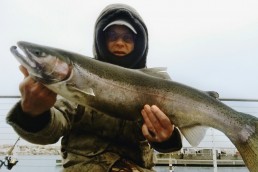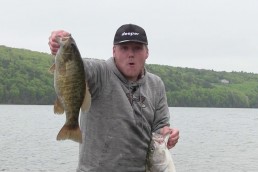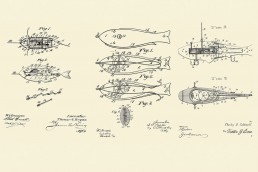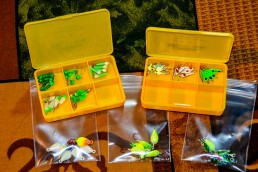Could these be the Top Two Lures for Shore Casters?
SHARE THIS POST
I started off the New Year with a bang—literally.
While walking out to a fishing site in January, I hit a patch of ice and my feet went straight out from under me. It felt like when Wile E. Coyote gets lured off a cliff by the Road Runner, pauses for a second to give the camera a terrified look, and then plummets to earth in a puff of dust. I’m not ashamed to admit that I carry too much gear in my ALICE Pack, which was designed for a soldier to carry about 75 pounds of gear. And while I don’t carry that much, my bag weighs in under 30 pounds. So, as I crashed down to earth, my entire body weight came down on this pack, and specifically, on the waist support, which was positioned right on or around my right kidney area. The pain was incredible, and I knew I’d thrown my back for a loop. I also knew I’d torn or deeply contused my latissimus dorsi, the “broadest muscle in the back.”
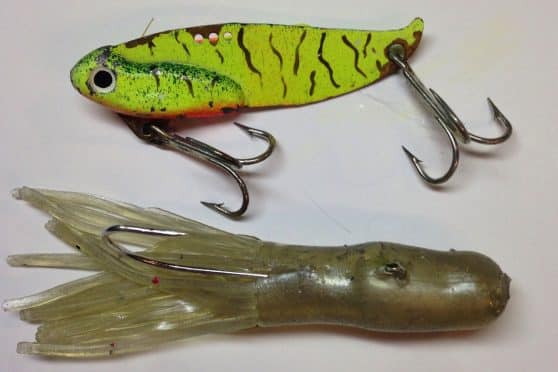
In this fall, I also had one Plano box of crankbaits shatter like glass. So, when the piers, docks, and breakwalls are covered with ice and snow, get yourself a pair of Ice Creepers or cleats. But more notably—something I’d never done before since I started shore fishing in 1974—reduce your amount of tackle. Sure I could’ve stopped fishing for several weeks to heal, but this wasn’t an option, for me.
As you can imagine, even just lifting this 30-pound backpack, let alone slinging it over my shoulder and wearing it, wasn’t going to happen. Even a smaller tackle bag caused a problem since I would have to kneel down to get a lure out, and getting down on my knees and back up was painful. My only option was to tie a lure on two different rods and live with them for the morning of fishing.
So what tackle to choose made me think about the evolution of lures for Lake Michigan shore casters. The 1970s had spoons, and variety of them with some spinners, especially if you were “on the edge.” Then we started to realize that some of these new crankbaits designed for bass and walleyes also mimicked our baitfish, and found that the trout and salmon loved them. The Thundersticks and Flat Warts were the go-to lure. Then we discovered that some soft plastics also developed for the bass world could translate into great shore-casting lures. But they all had a specific depth range, a specific time of the year for use, and specific species. The two lures that can catch all the salmonids at any point of the year, can be fished at a variety of depths and at a variety of speeds, would be my two lures, and there were two winners.
Are you enjoying this post?
You can be among the first to get the latest info on where to go, what to use and how to use it!
First is the blade bait. Whether it’s a Zip, Big Dude, Sonar, Binsky or any other brand, the blade is Mr. versatility. They cast a mile, work in all depths, work slow or fast and really appeal to all species we encounter along Lake Michigan’s shorelines. These are ideal at 1/3 ounce, and, surprisingly, not in silver but in white or a firetiger.
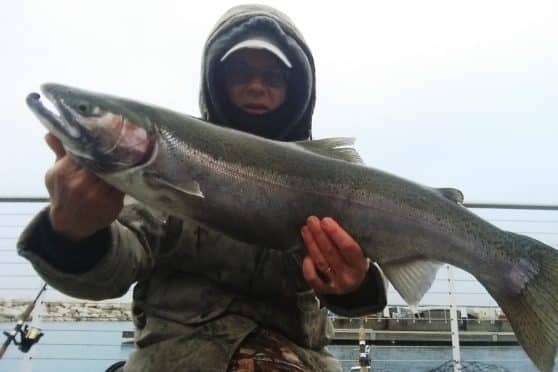
Second was a 3-inch tube jig on a 3/8-ounce head. They can be fished in 8 feet or 30 feet. Rip them, jig them, or simply swim them with just turns of the reel. And, use white pearl or a silver-grey if you can find them.
What made this experiment so interesting is that after being forced to use the two lures, I then went on a Joe DiMaggio-like streak on the browns and steelhead. My biggest issue now became netting fish with a sore back.
The back is better now and the streak continues, even though I can carry all that gear again. But this event had shown me that these two lures—ones that weren’t even on the radar for me the first 20-25 years of my shore fishing—were now the standard for me, just like those spoons back in the ‘70s and ‘80s. If these two lures aren’t in your Lake Michigan shore-casting repertoire, they need to be, sore back or not.
MWO
SHARE THIS POST
Did you enjoy this post?
You can be among the first to get the latest info on where to go, what to use and how to use it!
Marc Wisniewski
Marc Wisniewski is an avid Wisconsin angler specializing in Lake Michigan shore and inshore fishing. He also chases bass, pike, and muskies anywhere he can. He has built custom rods for 35 years and makes lures from wood, lead and soft plastics. Wisniewski has been writing fishing articles for more than 30 years.
